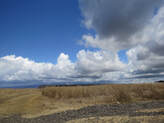 I feel like I am drowning in news at the moment, a sentiment I have heard other people express also. There is so much access to instant information that sometimes it can be incredibly overwhelming. Perhaps we need to step back, take a deep breath, and spend time sitting with the Lord in prayer, listening to what is going on both within our troubled hearts and within His Sacred Heart. The world has always been a complicated place and there have been messes, conflicts, natural disasters and the workings of evil since the beginning time. This is why God has continually tried to send us help in the form of holy leaders, prophets, and finally His own Son. God is an endless font of mercy and so He is doing everything He can to offer us healing and wisdom, but we have to take the time to cultivate the grace to cope with the things which are beyond us. There is so much beauty and goodness in the world that we have to be careful of falling into the temptation of losing sight of it while simultaneously keeping our eyes open to the temptations and evils which are around us. God knows this is a difficult balancing act, and that is why He continually sends the Holy Spirit to guide us on this perilous, yet incredibly beautiful journey called life. This past week one of the daily readings from the Old Testament taught a pertinent lesson about coping with evil. The passage I want to highlight is the one about the king of Judah who inherited the throne at the tender age of 18 and made a mess of it immediately. (2 Kings 24:8-17) The enemy who was literally at the gate was the Babylonians led by King Nebuchadnezzar. What facilitated the fall of the people was their collective refusal to listen to the word of God as spoken through Scripture and the prophets. They sat idly while the Temple was dismantled and all the important liturgical vessels were broken up and taken away by their plunderers, (they let their values be literally thrown aside). Then, three months into the young king’s reign most of the people were taken away into Babylon as exiles: “…all the officers and men of the army… all the craftsmen and smiths. None were left among the people of the land except the poor.” (2 Kings 24:14) The king, his mother, his ministers, and his entire retinue were exiled also. Only the poor remained while Nebuchadnezzar put a new king on the throne, Zedekiah, who would eventually allow the last bit of Israel to fall into dust. 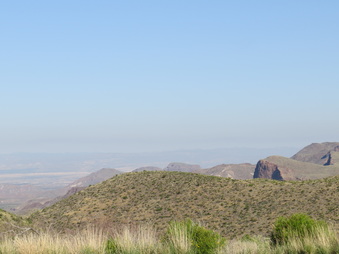 Though passages such as the one in the Second Book of Kings might seem to imply that the situation in the world is solely our fault, we need to keep things in perspective. Yes, our sinfulness and destructive behaviors do lead us far from God and therefore into dire times, but sometimes evil happens because it has gotten so big without anyone noticing for so long that it is no longer in our control. We do need to have some accountability, but it is not productive to become so stupefied with grief that we become stuck, nor is it always the case that we brought things upon ourselves; evil wants to have its way no matter what we do. An example of this is also in the Old Testament, about 500 years after the events of the Babylonian Exile, when the people remained faithful yet the situation of being oppressed by another pagan nation was so bad that it made the Exile pale in comparison. This time they suffered without having gotten far from God. It made no sense to them, but they still remained strong and brave in the midst of such tragedy. That is why we need to keep our world and the ravages of evil in perspective. Sometimes things happen that are so far out of our control that we would be foolish to sit around with nothing but self-recrimination and hand-wringing. There is a better way, and it is the way of Jesus. The key to seeing this is found in the above quoted verse: ‘only the poor remained in Jerusalem' when everyone else was deported. The gospel as taught by Jesus teaches us that the poor are near to Jesus’ heart. And it teaches us that to be like Jesus we need to embrace the simplicity of heart which He embraced. 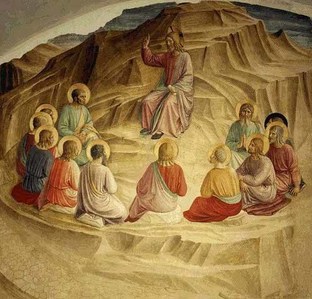 As Christians, we cannot lose sight that if we live as Jesus taught we should identify with the poor. This means that it is important to do more than only give to the poor in a material way. Rather, it is central to the gospel that we have the heart of the poor. In the Sermon on the Mount Jesus said, “Blessed are the poor in spirit.” He also said the blessed (or holy) are those who mourn, the meek, those who hunger and thirst after righteousness, the merciful, the clean of heart, the peacemakers, and those willing to be persecuted for the sake of justice. (Matthew 5:3-10) With a closer look at each of the Beatitudes it becomes apparent that at their core is the humility, or poverty of heart, which is necessary to know we all need the help of God before anything can be done about the situation around us. In spending time with Jesus, learning to imitate Him, our holiness grows so that we mourn over the injustices of the world, the suffering we witness in others and in ourselves, and (especially) we mourn our own participation in injustice through our sinfulness: that is, we recognize that we must accept responsibility for our own sin before we can work against the sin around us in the world. This stance will enable a growth in humility and meekness, which does not mean to become lily-livered, but rather it means to acknowledge our powerlessness without God. 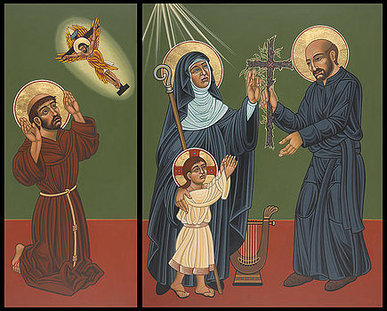 Living the Christian life means to adopt a disposition of radical openness to God by becoming poor, which means letting go of all the obstacles which stand in the way of our relationship with God and in becoming humble servants. Jesus told us exactly how to do this; there was nothing vague about His message of how to become holy and how to walk with Him. It is done by growing in purity of heart, which is to say, holiness, which calls us into a radical respect for others, even when we disagree with their agenda or behavior. (That, by the way, is what mercy is.) We grow in holiness when we hunger and thirst for righteousness, learning how to mix justice with mercy and discernment with action. We grow in holiness when we work for peace, and also when we stick to our values, even at the risk of suffering, willing to be persecuted for the sake of the gospel. This does not mean we will be arrested or tortured, though the sobering reality is that some people in the world will. But it does mean we are willing to stand out as Christians and that we are willing to be ridiculed for living honestly, walking in truth, attending religious services, reading our Bibles, doing good works (such as the corporal works of mercy from Matthew 25), returning kindness for evil, keeping hold of our tongue and withholding rude gestures when we are angered, refraining from gossip, and refusing to participate in things which go against the gospel of Jesus Christ. This is the message of the Old Testament writer who pointed out that “none were left among the people of the land except the poor.” Hooray for the poor who stayed behind and prayed for those who had suffered, for themselves, and for those to come! If not for them the faith would have been lost. And if not for their spiritual descendants, those who accepted Jesus when He came, we would not be here either. It is the poor who will lead the way: a Little Child, (as we heard in Advent), poor fishermen and farmers, (the first disciples), and the many men and women who persevered through trial and tribulation all while glorifying God for His richness in beauty, mercy, and love. 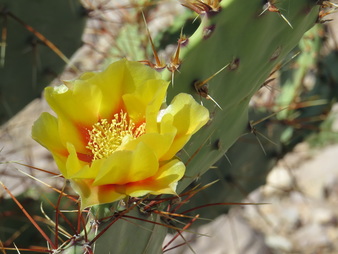 This is our call: to be as the poor. We do not have to give everything away in order to become monetarily poor, but we do need to be generous both within our material means and especially with our love. We do need to be humble, poor in spirit, to have our eyes continually opened to the power of Jesus and His mercy. We always need to have the vision to see what needs healing, but always while having gratitude for all the blessings we have and which we want to share and preserve for those who come after us. We need to ask God to help us keep everything in balance, neither becoming arrogant such that we lose our horror at sin, nor complacent, becoming paralyzed in the face of evil around us. Rather we need to rely upon the Holy Spirit to guide and empower us to withstand temptation, to help us live the gospel which is our roadmap to holiness, and to never let go of Jesus who will guide us all home to Heaven one day. May we be people of the Beatitudes, becoming pure of heart! May we continually pray for guidance, wisdom, and the grace to persevere with humility, but with the boldness to stand firm in our beliefs! May we act with justice and mercy, having the discernment to know how to combine both of those graces! May we have the eyes to never stop seeing the beauty in the world because we are distracted by the ugly things! And may we be as the poor, holding on to Jesus who let go of everything in order to save us! Let us continue to meet in the Heart of Jesus, clinging to nothing but Him. Peace! ©Michele L. Catanese All the photos are mine. This first one was taken in Little Rock, Arkansas on a nature trail. I chose this photo because it reminded me of the Sermon on the Mount in which Jesus said for us to look at the birds of the air who do not sow or reap yet are taken care of by the Father; and again later in the passage Jesus said for us to look at the flowers of the field which do not work or spin yet are arrayed in splendor. (Matthew 6:26-29) Jesus was speaking of the radical poverty of spirit needed to rely totally on the Father. Both the bird and the flowers in this photo speak of this passage. The next photo was taken in Big Bend National Park in west Texas. I chose this one because of the starkness of the scene. I was thinking of the Babylonian Exile and the Israelites' march through the desert to arrive in a foreign land. There is no greater poverty than having lost everything, including ones homeland. If you look closely, you can see mountains in the distance, suggesting a land far off. Next is a painting by Bl. Fra Angelico, called The Sermon on the Mount. The desert-like spot, the seemingly bare mountain where they are sitting, is almost shocking, but to me it says that the words of Jesus are teaching them to see more than is obvious. He is teaching them to see mercy, beauty, compassion, love and all that God desires for us to have in our interior landscape, as well as that which He is teaching us to see in others. Life will come into the desert of hearts that are far from God when we allow Jesus to enter. Next are two panels from a larger work called Viriditas: Finding God in All Things, by Fr. William Hart McNichols. In the far left panel is St. Francis of Assisi receiving the stigmata. St. Francis was often called 'Il Poverello' (the Poor One) because of his radical embracing of 'Lady Poverty.' He truly lived what Jesus described in the Sermon on the Mount. In the panel to the right are St. Hildegard, the Child Jesus, and St. Ignatius Loyola. St. Hildegard lived a poverty of spirit that allowed her to open her soul so greatly to God that she became a mystic who definitely had the eyes to see what so few could see. St. Ignatius is famous for teaching us to see God in all things especially through his Spiritual Exercises. I chose this icon because of the confluence of the holy people depicted. All are about seeing God in everything; all are about poverty of spirit. Notice the cross which is sprouting new life. The Christ Child is reaching up for it as if to say that His death upon that cross will sprout forth the new life of salvation. He is the Little Child that leads us. You can find the diptych and the entire work at http://fineartamerica.com/profiles/william-hart-mcnichols.html?tab=artworkgalleries&artworkgalleryid=584247. Last is a photo of a cactus in bloom taken at Big Bend National Park in Texas. I chose it because there is much life in the desert. In the midst of barrenness there is the potential for life; in fact, there is much beauty in any desert. There is a wealth in being poor. That is, when we make room for God, His beauty can take root within us. There is no greater wealth than that. 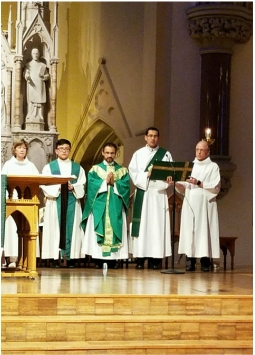 I have written previously about prayer, in fact, many times. Sometimes it has been about its power and other times about ‘how-to’ basics. It is time to return to this topic, especially because this week I read more than once about those who say prayer is ineffective or that prayer is not enough. I would strongly disagree with those two statements: the problem is not with prayer, but in our idea of what prayer is and what it does. Prayer is first and foremost part of a relationship, and as in any relationship it is based on mutuality, trust, and dialogue which therefore includes listening. There will also be mystery. We are often a mystery to our own self, and so it is no surprise that in a relationship the other is also a mystery. This is especially so with God. Though He has revealed a lot about Himself, He is vastly more mysterious than any other and His wisdom is far beyond anything we can grasp. Therefore because God is mystery, prayer involves faith. If we do not truly have faith in God, then we cannot trust our own prayer. And for prayer to be truly effective, it must change our own heart and move us outward. As Pope Francis once said, “You pray for the hungry. Then you feed them. That's how prayer works.” Prayer is everyone’s hotline to God. It is not something that one person has more of than another, nor are some people more readily listened to by God; God hears us all equally. While some people are rather eloquent, the best prayer does not require us to be so. It is the heartfelt and sincere prayer which is ‘best’, such as “God help me/us/them.” God is not judging the quality of our grammar or the poetry of our language, but rather He hears what is articulated and also what is beyond words. Prayer is not getting what we want when we want it, no matter how ‘great’ what we desire might be. If our prayer seems to go unanswered, it may be because there is too much complexity involved, all of which is beyond our understanding. 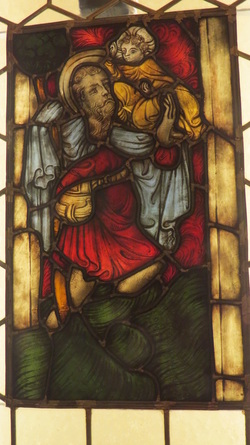 We need to remember that God never promised that we would be free of suffering. God does not cause evil or suffering and God does not condone it. But He does allow it because it is part of the freedom given all things. Rather than forcing us to be puppets that are only able to do what He wants, God gave the gift of freedom, which means that wickedness can be chosen as well as good. That is simply the way it is. Because of sin, Jesus suffered and died to offer a way into heaven and He is continuing to battle malevolent forces through the efforts of good people. And this is why prayer is so important: it changes our hearts and it enables us to be the hands and feet of Jesus in the world today. Prayer gives us immense power. That is how prayer works. Through prayer, what we always receive from God is the power to endure, the power and grace to work for justice, and the power to affect the lives of others. Think about a time when someone told you they would pray for you. What was the effect of such a promise? I know that whenever someone says this to me I feel more confident regarding whatever my need might be. I also feel less alone and more empowered just by knowing that someone cares enough to enter into my mess, and that because of their prayer I have a deeper sense of God’s presence, of God holding me close, and of God giving me the strength to endure whatever it is I am facing. In short, when someone tells me they will pray for me it inflames my trust in God. That is how prayer works.  Being people of prayer does not mean we are to become passive like a doormat. Rather, Jesus taught that to be Christian means to fight evil with mercy and love, not with violence. One of the many gospel passages which support this is when Jesus said, “Behold, I am sending you like sheep in the midst of wolves; so be shrewd as serpents and simple as doves. But beware of people, for they will hand you over to courts and scourge you….” (Matthew 10:16-25; please read this entire passage.)* Jesus was basically saying that anyone who is truly His disciple, living as He taught, will be subject to attack, so we need to be prepared for how we want to respond. This means we are to be alert for danger especially at the hands of enemies. But our response is to be one of peace and respect. The Holy Spirit will be with us, speaking for us, so we will know how to use our God-given talents with courage and hope. Truly, all of Jesus’ teaching is about loving responses, working for justice, spreading the gospel, helping the poor, reaching out to the imprisoned, sick and marginalized, but none of it is sugar-coated. One has only to read the gospels to know that we are not meant to sit around and do nothing. Christianity is a religion of doing and working, not of passivity. Therefore, our prayer is meant to help us to have the courage, the grace, and the discernment to know how to proceed given the circumstances of our lives. Our prayer will help us to know when we are to involve ourselves in organizations which work for peace, or to give money to causes that are consistent with the gospels, or to be a presence in our community just by being a witness to our faith, and it will always help us to vote in ways consistent with gospel values. That is how prayer works. 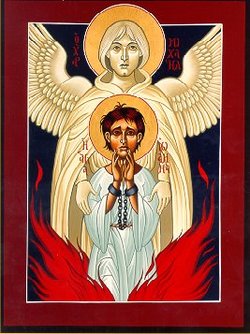 St. Theophan the Recluse († 1894) wrote: “The prayers of the poor are powerful. You, too, go and multiply your alms: wipe the tears of the unfortunate, shelter if you can the destitute. The prayerful moans of the impoverished reach heaven and pass through the heavens of heavens.” This is not just about being monetarily poor, but it includes all of us who are spiritually poor from time to time, such as when a disaster or tragic event takes place, when we are stunned, mourning, or outraged at what we have seen and heard. Therefore it is important to recognize that our prayer is powerful especially when we feel the most powerless and vulnerable. Some may ask why the prayers of many seem to go unanswered when they are praying for safety and it does not happen. Do we definitively know that their prayers actually went unanswered? Their lives had meaning without a doubt. We can look to the many martyrs throughout history and know that while some seemed to embrace martyrdom, many did not. One of my favorite saints is such a one: St. Joan of Arc did not embrace martyrdom at all, crying out to Jesus to save her as she was consumed by flame. Her life had great meaning and effect, even though she was an unschooled French woman who died very young. While not everyone who dies in a tragic, violent way will be remembered as vividly as St. Joan, they are our brothers and sisters, and they are part of the fabric of our lives whether we recognize it or not. Prayer is effective and we need it now more than ever. We need to listen, discern, and wrestle with angels like Jacob if need be, but in the end the greatest power we have is the love, mercy, and compassion which can only come to us from God. That’s how prayer works. 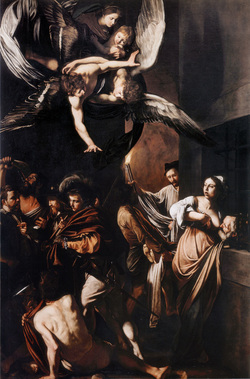 May we find our way to God in prayer, trusting in His promises! May we utilize the gifts of faith, hope, and love, trusting that God hears our prayer, no matter how He seems to respond! May we have the courage to oppose injustice and hatred both in our prayer and in our actions! May we support all our brothers and sisters in prayer which moves us outward to them! May we persevere in our desire to grow in holiness, not so much for our own sake, but in order to work at building the Kingdom of God! May we continue to live this Year of Mercy with active gratitude for God’s mercy by making a special effort at becoming mercy! And may we learn to have the heart of Jesus, returning love for hate and kindness for contempt! Let us continue to meet in the Heart of Jesus! Peace! ©Michele L. Catanese * Here is the link to the passage from Matthew which I quoted: https://www.bible.com/bible/463/mat.10.16-25.nabre I also encourage everyone to pick a Gospel and read it end to end. I would suggest Luke since his gospel has prayer and reaching out to the outcast as two of its main themes. The photographs are all my own except this first one, which was taken by Mary Solcher. It is from the Mass of Thanksgiving presided over by newly ordained Fr. Roy Joseph, SJ. The deacon beside him was leading the congregation in the Prayers of the Faithful. I chose this because of the fervor of the prayer at this Mass and also because of the very moving homily which Fr. Roy gave which included the topic of mercy. (Thanks for letting me use this wonderful photo, Mary!) Next is a photo I took in Salzburg, Austria. There was a display of stained glass inside our hotel which was actually a historic building. This glass depicts St. Christopher carrying Jesus across a river. According to legend, Christopher (from the Latin, Christophorus which translates to 'Christ-bearer') carried the Christ Child across a river, and when asked why He was so heavy, Jesus responded that He carried the weight of the world on His shoulders. I chose St. Christopher, though he is shrouded in legend, because when someone tells us they are praying for us, it is as if they have begun to carry us and our burdens. It is an act of love to pray for a friend and yes, even an enemy, as Jesus calls us to do. You can read about St. Christopher by clicking on this link: http://www.catholic.org/saints/saint.php?saint_id=36 Next is a photo of a hang-glider which I took at the Zugspitze, the highest mountain in the German Alps. It takes a lot of courage and faith to hang-glide in a place like the Alps. I chose this photo because sometimes we have to do something that feels a little dangerous because of our commitment to prayer, and ultimately to Jesus Christ. It is dangerous to love, to offer mercy, and to live Christian values in a world which is often hostile to them. But it is what Jesus asks of His followers, and He sends the Holy Spirit for us to glide upon and to empower us. We are safe with the Spirit surrounding us. Next is an icon called St. Joan of Arc with St. Michael the Archangel, by Fr. William Hart McNichols. I love this icon because St. Joan is the patron I chose for my Confirmation and I am named for St. Michael, therefore it is incredible to have both my patrons in one icon. But I selected this because it depicts the terror of Joan as she endured the fire, yet St. Michael is separating the flames which are like sails on either side of her. He was with her in the flames, comforting her. For those who feel like they are in the flames right now, St. Michael will surround and comfort you, too. This icon can be found at http://fineartamerica.com/featured/st-joan-of-arc-with-st-michael-the-archangel-042-william-hart-mcnichols.html. If you go to the site, you can purchase a copy of this icon, which is available in many different formats. Information on St. Theophan the Recluse: http://oca.org/saints/lives/2016/01/10/100147-st-theophan-the-recluse-the-bishop-of-tambov Finally, the last image is a painting by Caravaggio called The Seven Acts of Mercy. I chose it because Pope Francis referred to it as one of his favorite paintings and therefore it tied in with the theme of this post as well as the frequent repetition of the Pope's words: "That's how prayer works." It depicts the action to which prayer moves us. I am providing a link to an article about Caravaggio and this work: http://ncronline.org/news/art-media/caravaggio-masterpiece-mercy-calls-pope-francis-across-centuries  I vividly remember writing an essay in high school as part of a final exam on the short poem by Robert Frost, Stopping by Woods on a Snowy Evening. Our teacher used this early, short poem of Frost to teach us a valuable lesson: an awareness or type of hearing, if you will, of what was between and even beyond the words. The poem, fittingly, is about listening, and in the simple text I can almost hear the falling snowflakes alighting on the leaves of the trees, see the surrounding darkness of the woods, and feel the cold of the winter’s night. I have always admired poets who can put words together so skillfully that they sing with meaning or have the ability to burrow deep into the soul. As artfully as words can be spun, I especially value the power of words when I do not have them myself, such as at this moment when I literally cannot speak due to a case of laryngitis. There is a hidden gift in this temporary ‘affliction.’ It is that I must listen more carefully since I cannot do otherwise. As you might have guessed, this reflection is on the gift and art of listening. It is also about how communication is not really about words, but rather about deeper realities. And sometimes it is about learning to use other senses in order to hear and respond to God. Having little ability to speak necessitates finding alternate ways of communicating. It means becoming creative in conveying meaning in some way that does not require spoken words. It also forces me to listen more intently to those around me and it provides an opportunity to listen more deeply to God since the distraction to focus on self which I can create with my own voice is no longer available. It offers an atmosphere of other-centeredness, especially when focusing on God; it also fosters gratitude for the gift of speech, suddenly recognized because of its absence. But the real challenge is that just as one does with a piece of poetry, being temporarily silent means having to learn to ‘hear’ beyond and between the words, since I can do little to fill the space. Another way to express this is that being silent is a reminder that we all need to find ways of being attuned to God since we know that ordinarily when God speaks it is not with words that we hear with our physical ears, but rather it is something to which all our senses must be applied. Being silenced helps us to discern His presence in the world around us and within our own hearts. 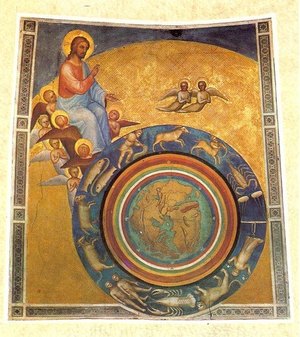 God our Creator has communicated with His people throughout salvation history. Those who were attentive to God’s inspiration provided us with the written Word of God, the Bible, and so we can prayerfully open ourselves to the wisdom God tried to impart to His people during their struggle to be faithful to Him by reading the various books within it and doing some serious study. He sent us Jesus as His spoken Word (John 1:1) that we might know the great beauty of His love and mercy which are extended to us. We should ponder the message of Jesus in the gospels, learn how to discern the movements of the Holy Spirit, or find something about the way God does justice with mercy so that we know the way to proceed in difficult situations. But God also communicates beyond words through that which He has created. St. Hildegard of Bingen expressed this in her teaching about viriditas, which is the lushness or greenness of creation, a reference to the power of God’s presence which enlivens all things with life and light. For Hildegard, viriditas included the life-giving and healing power found in various plants, that the written word, (sung or spoken) evokes emotions and images, and that each person is also a reflection of God’s own beauty. She wrote: “Every creature is a glittering, glistening mirror of Divinity.” This is how God intends us to see ourselves, because this is how He sees us. But if we have never received this message we might lack respect for ourselves which could then translate into a lack of respect for others. It would be good for us to allow the words of St. Hildegard to resonate within us so that we can hear God speak His love and mercy deep within our own hearts, healing whatever distorted beliefs we might harbor in regard to ourselves and also the ones we may extend toward others. God sees us as a reflection of Himself, and the only way to begin the path to wholeness (holiness) is to take Him at His word. 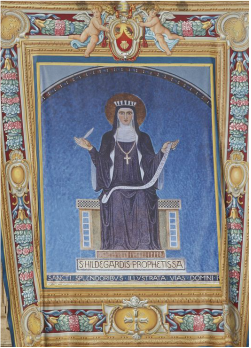 In all relationships communication is the ‘tool’ we use to reveal our identity to one another. Therefore, prayer is a large part of the intimate relationship which God desires to maintain with us. Prayer is not simply a litany of words, requests, or desires, but it is a dialogue, which means we need to learn how to observe the presence of God within and around us, so we can be open to His response. If we do not learn to let Him ‘get a word in edgewise,’ then we are not fully engaged in communicating with Him. Vocal prayer (saying traditional or rote prayers) is an important part of our communication with God, and so is intercessory prayer, but another essential part of our prayer time which should not be neglected is the time we spend in meditation, allowing Him to move our hearts and open our spiritual eyes and ears. It is in this time that we invite God into dialogue, or perhaps spend time simply sitting with Him. People of prayer, and not only of prayers, are people who know how to listen. In our listening we become humble, having put God before our needs and wants, and in doing so, we grow in holiness. If we learn to listen and observe, we can discover the deeper realities which go beyond words that He wants to reveal, messages of His love and mercy for us. In being silent before God we are freed to become imitators. One cannot imitate someone to whom we do not really give full attention. If we truly desire to become holy, to mirror God, we need to open our ears to Him. Being silent is not always about becoming passive, though this is appropriate at certain times. However, when we are listening to another person, being silent is actually a type of activity: we need to actively listen, that is, to put effort into hearing what it is the other is conveying. We communicate our caring by laboring to be truly present to them. There are times when we know our words will fall short, so we simply are with the other, unchaining them from the burden of aloneness. Also, we have heard the adage that ‘silence speaks louder than words:’ there are situations in which keeping quiet about something is the greater good, and there are other times in which speaking up is necessary. But in order to know which is which, we need to first be silent, praying for wisdom. Then if we are to speak, we need the continued wisdom to know what to say. Sometimes the Lord is asking us to quietly get out of the way and let Him do what only He can do or reveal something only He can reveal. And when difficult things do need to be said, if they are said with love, no matter how challenging the situation may be, we are to say them. If we remember that love is always the intention of the follower of Jesus, then we will know what to do and whether the time is right to act.  Listening is an art, and as an art it needs to be practiced. And like any other art form, listening can become a beautiful gift we offer the world. While not all of us will be able to express what we hear by writing gorgeous poetry, we can become a poem through our presence and our little deeds of love. And while not all of us can create masterful paintings, (or works of any other artistic medium), we can all learn, as St. Hildegard suggests, how to see that “every creature is a glittering, glistening mirror of Divinity.” If we learn to see and respond in this way, to come to recognize the priceless work of art which God has created each one to be, (Ephesians 2:10) we will come to be accept that we, too, are a mirror of Divinity as one of God’s holy people. It is a process, and it is something to which we are all called. Let us learn to practice silence, not only when sickness forces us, but on a daily basis, so that we might learn to perceive the Word, Jesus, who is with us at every moment. May we be open to learning the art of listening! May we trust that God listens to us when we pray, and may we be accepting of His response! May we begin to see Divinity mirrored in every creature, including ourselves! May we use our words and deeds to communicate peace, healing and love, but also have the courage to speak difficult truths if we are called to do so! And may we discover God the Father, Jesus the Son, and the Holy Spirit mirrored to us, and indeed present to us, through creation and in the artistry of our brothers and sisters! Let us meet in the Heart of Jesus! Peace! ©Michele L. Catanese The text of Robert Frost’s poem, Stopping by Woods on a Snowy Evening can be found at http://www.poetryfoundation.org/poems-and-poets/poems/detail/42891 The first image is a painting by Fr. William Hart McNichols which is part of a triptych which was commissioned by a funeral home in Taos, New Mexico. It is called Tree Triptych for Rivera Funeral Home. I chose this work because is seemed to speak of the solitude which Robert Frost was describing in the poem. Honestly, I love every icon or image that Fr. Bill paints which has stars and the moon in it. His renderings of the night sky are always meditation points for me, no matter what else is in the icon or image. There is always a sense of peace evoked in his night skies. But what I love most about this image, however, is the small candle in the bottom left hand corner. It speaks to me of hope and of Christ who is the Light which dispels all darkness. The wind seems to be trying to blow out this flame, but the flame prevails, as does Jesus. To view the entire work, and to see the other two trees which appear with this one in the triptych go to http://fineartamerica.com/featured/tree-triptych-for-rivera-funeral-home-220-william-hart-mcnichols.html. Next is The Creation of the World by Guisto Menabuoi, an Italian painter from the Florentine school. (1320-1391) I chose it because it reminded me of the beginning of Genesis in which God spoke "Let there be..." and things came into being. It was the word of God which created, breaking the silence of eternity. It also made me think of viriditas, the lushness and bounty of creation, all of which is charged with the presence of God, the life-giving Creator, the Artist of all Artists. You can find more on this work at http://www.fineart-china.com/htmlimg/image-51701.html. By the way, if you look closely you can see layers of golden light, earth-colored brown, and green (viriditas?) surrounding the orb which seems to represent the earth. Third, is a mural which shows St. Hildegard of Bingen sitting on what seems to be a throne, maybe the throne of wisdom and truth, though most likely a reference to her position as abbess in her community. (The inscription under it states that she is a prophet, actually). She is seen to be writing, something she did quite prodigiously. Maybe she was writing about viriditas, or perhaps the quote found in this entry. This wall mural is in the church at St. Hildegard Abbey at Rudesheim am Rhein in Germany. (Fr. Bill McNichols also has some wonderful icons of St. Hildegard which do not appear in this piece, but you can find them at http://fineartamerica.com/profiles/william-hart-mcnichols.html?tab=artworkgalleries&artworkgalleryid=576462 and http://fineartamerica.com/featured/st-hildegard-of-bingen-171-william-hart-mcnichols.html.) Finally the last image is one of my own photos taken at Crater Lake, Oregon. I chose this because of the stillness of the water. There was a profound silence in this spot except for the faint sound of the gentle breeze. Because there are no currents in this lake which literally fills up a volcanic crater, the image of the mountains and clouds are mirrored perfectly. If you look really closely, on the left side of the photo you can see a cloud which seems to be floating on the water just above the tree tops: it is a mirror image of the actual cloud in the sky directly overhead. Indeed, all of creation is "a glittering, glistening mirror of Divinity!" 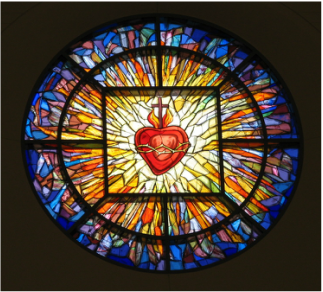 Usually when we think of the heart we think of love. This is especially true when we describe a charitable or kind person as being ‘all heart.’ We often refer to the heart as the seat of love within a person, though centuries ago it was strangely thought to be the liver! This past weekend marked two special liturgical feasts which center upon the heart and on boundless love. On Friday we observed the Solemnity of the Most Sacred Heart of Jesus and on Saturday was the memorial of the Immaculate Heart of the Blessed Virgin Mary. Each of these liturgies celebrates the gift of love and mercy which is offered to us by God. And each focuses on what was needed in order to bring God’s love incarnate into the world: that of the Son of God who loved us so much that He was willing to save us by entering our world in order to take on our brokenness and suffer for us, and the generous response of a woman, Mary, whose love made God’s desire to be with us a reality. As expressed in last week’s entry we see that love enkindles us as if we are afire. Maybe this is why the hearts of Jesus and Mary are always depicted as luminous and burning with love. 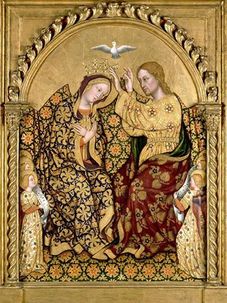 The goal of our lives as Christians is to become holy, which means to be consumed by love in imitation of Jesus. We have the example of the saints who are our inspirational heroes because they have done just that. They prove to us that holiness is possible for everyone, given that they all had circumstances and gifts which were unique. Mary is the Queen of Heaven and therefore is also Queen of the Saints, since her heart was (and remains) ever pure and immaculate. Like Mary, what transformed the men and women who we see as holy is the love they first received from God and to which they responded with their own ‘yes’ because their hearts learned to beat solely for love of God. They help us to see that being Christ-like is not impossible and that there are as many ways of being holy as there are people. In other words, we become holy based on the path put before us; every journey to holiness is as singular as the person on it. 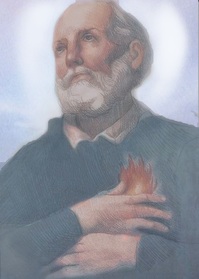 The one common denominator in the lives of the saints, along with Mary, is the presence of an overwhelming ability to love. A great example of such a one is St. Philip Neri (1515-1595) whose feast day was on May 26. He lived during an era in which there were many holy people eventually named as saints such as St. Teresa of Avila and St. Ignatius of Loyola. As a young man he was filled with an immense love for God which culminated in a vision while praying in which he saw a ball of fire enter into his chest. The fire of God’s love was what entered into him and it was said that after this experience he radiated such warmth that he never had to wear a coat, even in winter. Philip was literally warmed by God’s love, and it was this love which he radiated through the works of charity he offered for many people throughout his life. It was discovered after his death that his heart was so large that it literally bent his rib cage outward to accommodate the space it needed! In other words, he was filled with so much love, (and luminosity, too) that it literally emanated from within him. There are multitudes of saints who we could investigate to learn how their hearts beat in tune with that of Jesus and how they shared that love in their own unique way. If we desire holiness, (and well we should since all are capable of it), then we need to learn how to let our hearts be more in touch with the love of God offered to us. If we recognize how deeply God loves us, we can be filled to overflowing, too. A good place to start is to study the Bible, which is truly a book about love. And there is no love story greater than that of the gospels, which proclaim the works and words of Jesus whose very life was an offering of love for us. He truly wanted to save us, and even wept over His people, at one point comparing Himself to a mother hen who longs to gather her young under her wings. (Matthew 23:37) He allowed His Sacred Heart to be broken for us, as we can see by the depiction of His heart surrounded by a crown of thorns and bleeding from the wound of the lance thrust into his side on the Cross. The words we read in Scripture can help us to be inspired to respond to the great gift we have been given: we can immerse ourselves into the Sacred Heart of Jesus through prayer and beg Him to help us to do everything with love. That prayer, in turn, will enable our daily response to take flesh through our own words and deeds. The point of becoming holier is that our hearts transform with the love of Christ, and therefore, we begin to love heroically. It starts small and it grows into a way of life. 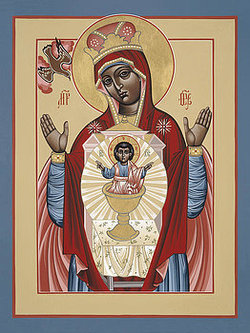 In doing small, seemingly insignificant things with love, we will also transform the hearts of others. This is not always easy and it is especially challenging when we are suffering, but we can, for example, learn to demonstrate patience with everyday annoyances, difficulties, and the inconveniences that pop up. Acting with patience definitely affects others around us, showing them that it is the better, more peaceful way. If we can in prayer for compassion in dealing with a difficult person, if we can forgive little offenses such as a rude comment, and if we can let go of the silly little things which in the light of eternity are in fact, silly little things, then we are learning to love better. Our small acts of love become habitual so that we begin to live mercy and charity. And when this happens even the heaviest of burdens seems to grow lighter. The biggest challenge of our times right now is the affront to love and mercy: we are taught by public figures and by what we watch on TV that rude behavior is not only okay, but that it is an entire way of life which is acceptable. We witness acts of rage, whether on the roadways or in supposed retaliation, carried out by people who have become detached from love, as if momentarily possessed. We see selfishness which is perpetuated by a society that seems to endorse becoming ‘successful’ by whatever means it takes, and which encourages us to seek out pleasure rather than the good of others. We are also aware of aggression which comes from different groups or cultures, and for that matter, we are even challenged by catastrophic natural disasters that are beyond our control. All we can do is to move against these evils or uncontrollable events by responding with the love we have been taught by Jesus. In working to build the Kingdom, Christians have fought these battles throughout history. But God has continued to empower us with the grace to stand firm in our resolve, so even if today’s issues are too big for us to counteract, we will find that resting in God’s love will help us to persevere. Love gives us the ability to trust that God will prevail in the end. Indeed, the Sacred Heart of Jesus and the Immaculate Heart of Mary teach us that the gentleness of love is the greatest strength of all.  The Sacred Heart of Jesus calls us to immerse ourselves in His mercy and love so that we can be beacons of light in the midst of a world which encroaches upon all that is good. The Immaculate Heart of Mary reveals to us an intercessor we can approach who will aid us in our quest for holiness. If we allow ourselves to be immersed in the love of God through the hearts of Jesus and Mary, we can become like St. Philip with hearts that warm others with love. Though some powers stand against love and would enjoy nothing more than to thwart it, we need to remember, as St. Paul so beautifully wrote, that “nothing can separate us from the love of God in Christ Jesus our Lord.” (Romans 8:31-39) Therefore, we have nothing to fear as we venture forth from our homes each day, desiring to live the love of God in all that we do. And if we fail along the way, as we will do from time to time, we know that His mercy will heal all our failings and empower us to dust ourselves off and try again. Let us turn to the Sacred Heart of Jesus and the Immaculate Heart of Mary for safety in the storms of life, and for love, mercy, and inspiration to live courageous lives of faith. 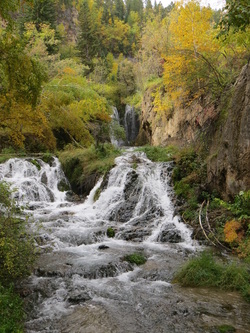 May we rest in the Hearts of Jesus and Mary which are filled with great love for us! May we be luminous beacons of love in the midst of a world which is in great need of light! May we be courageous in our desire to spread love every day in even the smallest acts! May we trust the presence of Jesus with us as we try to stay strong in our Christian faith! And may we desire to grow in holiness and learn to find Jesus in the midst of every decision, guiding us along the path of love! Let us meet, along with our Immaculate Mother Mary and all the holy ones, in the Sacred Heart of Jesus! Peace! ©Michele L. Catanese The first image is the Sacred Heart of Jesus beatifically rendered in stained glass. I took this photo at the Co-Cathedral of the Sacred Heart in Houston, TX. The second image is a bas relief of the crowning of Mary as Queen of Heaven. I chose it because I like the medium, which is wood, and I also liked that it was mostly gold, suggesting the luminosity I wrote about last week. Next is a painting called St. Philip Neri Lead Us to Heaven. There was no artist credited with this painting, which I found as the result of a Google Search, admittedly. I chose this one from the many I found because it showed the burning heart of St. Philip. It is rare to actually see it in a depiction of him, yet it is so much at the core of his life and ministry. Truly, I cannot imagine a painting of him without his heart aflame with the fire of God's love shown in some way. Next is an icon by Fr. William Hart McNichols called The Black Madonna Your Lap Has Become the Holy Table. I chose this because of the almost overwhelming radiance of Jesus within the womb of Mary which is symbolized as an altar. To me this says that in becoming pregnant with Jesus, Mary is the first tabernacle, alive with the presence of Jesus, and therefore His radiance also bursts forth from her. Her raised hands are both a gesture of praise and a reminder of her humbly saying to God: "Let it be done to me according to your word." And so, the Word becomes flesh. This icon can be found at http://fineartamerica.com/featured/the-black-madonna-your-lap-has-become-the-holy-table-060-william-hart-mcnichols.html Next is another of my photos which is of a sunset over the Badlands of North Dakota. I chose it because the sun seemed to be a beacon of light in the encroaching darkness. Finally is a photo I took in South Dakota of a waterfall which was not far from the road on a hiking trail in the Black Hills. I chose it because there is so much light in this photo. The bright gold of the leaves and that water seem to almost emanate light of their own. |
Heart Speaks to Heart
|

 RSS Feed
RSS Feed
